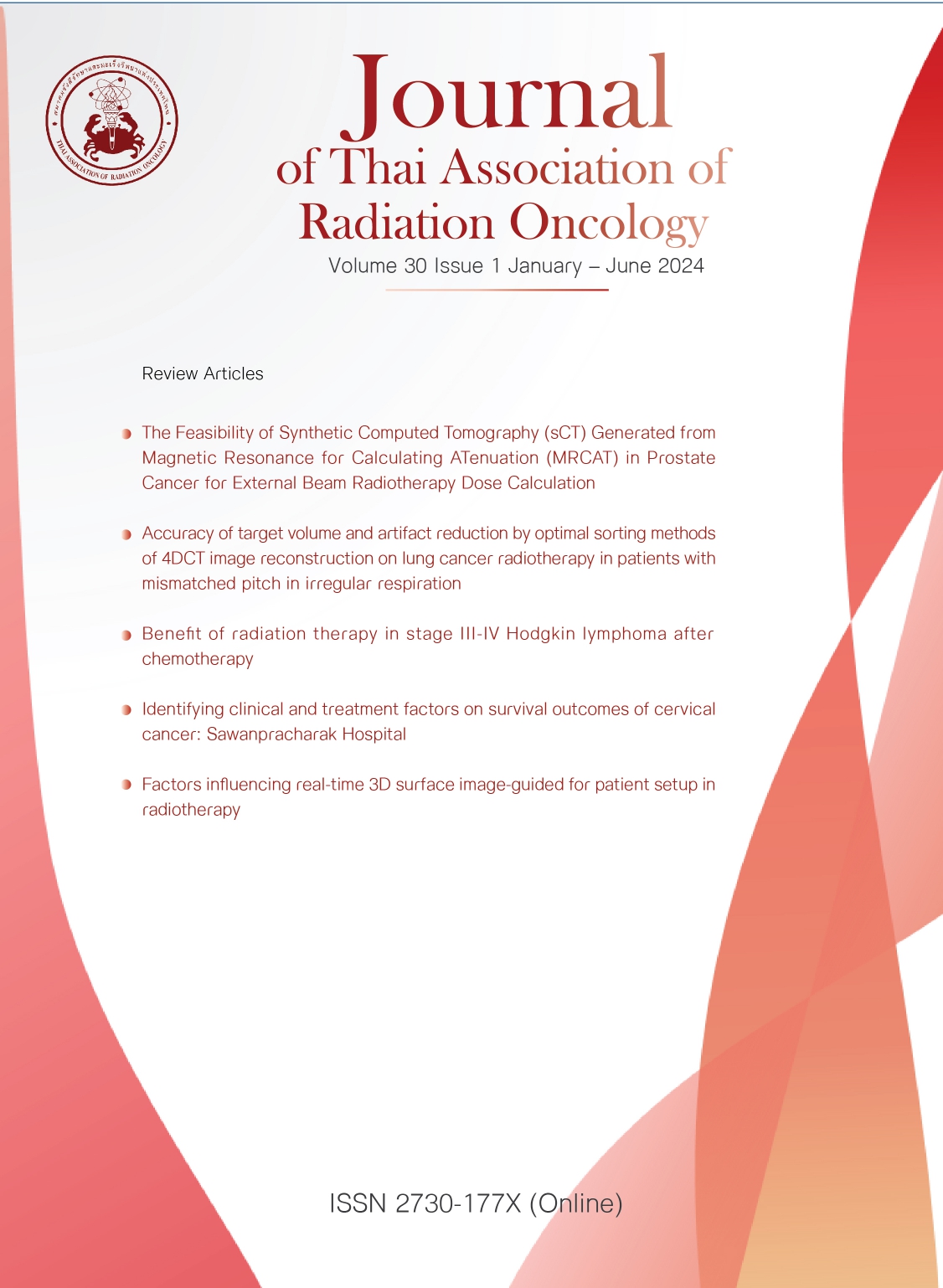ความเป็นไปได้ของการใช้งานภาพเอกซเรย์คอมพิวเตอร์สังเคราะห์ที่ได้จากภาพคลื่นแม่เหล็กไฟฟ้า คำนวณการลอดทอน (เอ็มอาร์แคท) สำหรับการคำนวณปริมาณรังสี ด้วยเทคนิครังสีรักษาระยะไกลในมะเร็งต่อมลูกหมาก
คำสำคัญ:
เอ็มอาร์แคท, การวางแผนการรักษาด้วยเอ็มอาร์เท่านั้น, มะเร็งต่อมลูกหมาก, ภาพซีทีสังเคราะห์บทคัดย่อ
หลักการและเหตุผล: ภาพคลื่นแม่เหล็กไฟฟ้า (เอ็มอาร์) ถูกนำมาใช้ในการคำนวณปริมาณรังสีสำหรับรังสีรักษาระยะไกลมากขึ้น เนื่องจากสามารถแสดงความแตกต่างของเนื้อเยื่อได้ดี อย่างไรก็ตามการคำนวณปริมาณรังสีด้วยภาพเอ็มอาร์ยังขาดความสัมพันธ์ระหว่างความหนาแน่นวัสดุและเลขซีที ซึ่งจำเป็นต่อการคำนวณปริมาณรังสีในเครื่องวางแผนการรักษาเชิงพาณิชย์ ดังนั้นภาพซีทีสังเคราะห์จึงถูกพัฒนาและนำมาใช้ในการคำนวณปริมาณรังสีในรังสีรักษาระยะไกล
วัตถุประสงค์: เพื่อตรวจสอบความเป็นไปได้ในการใช้ภาพซีทีสังเคราะห์จากเอ็มอาร์แคทในการคำนวณปริมาณรังสีเทคนิครังสีรักษาระยะไกลสำหรับผู้ป่วยมะเร็งต่อมลูกหมาก
วัสดุและวิธีการ: ผู้ป่วยมะเร็งต่อมลูกหมาก จำนวน 10 ราย ได้รับการจำลองการรักษาโดยสร้างภาพซีทีและภาพซีทีสังเคราะห์โดยใช้โปรโตคอลก่อนการสร้างภาพ ขอบเขตรอยโรคและอวัยวะสำคัญใกล้เคียงถูกกำหนดบนภาพซีทีและภาพซีทีสังเคราะห์ แล้วทำการเปรียบเทียบเลขซีทีของแต่ละอวัยวะระหว่างค่าที่ได้จากภาพซีทีสังเคราะห์และภาพซีที ภาพแผนการรักษาเทคนิคการฉายรังสีแบบปรับความเข้มหมุนรอบตัวถูกสร้างขึ้นโดยอาศัยภาพซีที ปริมาณรังสีถูกคำนวณด้วยอัลกอริทึม Acuros XB ด้วยเครื่องวางแผนการรักษา Eclipse (เวอร์ชั่น 16.1) จากนั้นแผนการรักษาถูกถ่ายโอนและทำการคำนวณปริมาณรังสีใหม่โดยอาศัยภาพซีทีสังเคราะห์ ความเหมือนของการกระจายรังสีระหว่างการคำนวณโดยอาศัยภาพซีทีและภาพซีทีสังเคราะห์ถูกประเมินด้วยพารามิเตอร์ของปริมาณรังสี และการวิเคราะห์แกมมาแบบ 3 มิติ
ผลการศึกษา: เลขซีทีระหว่างภาพซีทีสังเคราะห์และภาพซีทีมีความแตกต่างกันเล็กน้อยในบริเวณเนื้อเยื่อ (13.02 ± 15.58 HU) และมีความแตกต่างกันเพิ่มมากขึ้นในกระดูกโคนขา (51.59 ± 49.08 HU) โดยเลขซีทีในภาพซีทีสังเคราะห์มีค่าสูงกว่าภาพซีทีในบริเวณเนื้อเยื่อและต่ำกว่าในบริเวณกระดูก การกระจายรังสีที่ได้จากการคำนวณโดยอาศัยภาพทั้งสองมีความคล้ายคลึงกัน (อัตราผ่านค่าแกมมา >95% ทุกเกณฑ์พิจารณา) และไม่พบความแตกต่างเมื่อพิจารณาค่าพารามิเตอร์ของปริมาณรังสีในอวัยวะสำคัญใกล้เคียง
ข้อสรุป: ภาพซีทีสังเคราะห์ที่สร้างด้วยเอ็มอาร์แคทสามารถคำนวณการกระจายรังสีได้ไม่แตกต่างจากภาพซีที การศึกษานี้ส่งเสริมการนำภาพซีทีสังเคราะห์ด้วยเอ็มอาร์เท่านั้นมาใช้ในขั้นตอนการรักษาด้วยรังสีระยะไกลในผู้ป่วยมะเร็งต่อมลูกหมาก
References
Engeler CE, Wasserman NF, Zhang G. Preoperative assessment of prostatic carcinoma by computerized tomography. Weaknesses and new perspectives. Urol 1992;40:346-50.
Rasch C, Barillot I, Remeijer P, Touw A, van Herk M, Lebesque JV. Definition of the prostate in CT and MRI: a multi-observer study. Int J Radiat Oncol Biol Phys 1999;43:57-66.
den Hartogh MD, Philippens MEP, van Dam IE, Kleynen CE, Tersteeg RJHA, Pijnappel RM, et al. MRI and CT imaging for preoperative target volume delineation in breast-conserving therapy. Radiat Oncol 2014;9:63.
Platt JF, Bree RL, Schwab RE. The accuracy of CT in the staging of carcinoma of the prostate. Am J Roentgenol 1987;149:315-8.
Claus FG, Hricak H, Hattery RR. Pretreatment evaluation of prostate cancer: role of MR imaging and 1H MR spectroscopy. Radiographics 2004;24 Suppl 1:S167-80.
Turkbey B, Albert PS, Kurdziel K, Choyke PL. Imaging localized prostate cancer: current approaches and new developments. Am J Roentgenol 2009;192:1471-80.
Tyagi N, Fontenla S, Zelefsky M, Chong TM, Ostergren K, Shah N, et al. Clinical workflow for MR-only simulation and planning in prostate. Radiat Oncol 2017;12:119.
Goudschaal K, Beeksma F, Boon M, Bijveld M, Visser J, Hinnen K, et al. Accuracy of an MR-only workflow for prostate radiotherapy using semi-automatically burned-in fiducial markers. Radiat Oncol 2021;16:37-49.
Nierer L, Eze C, da Silva Mendes V, Braun J, Thum P, von Bestenbostel R, et al. Dosimetric benefit of MR-guided online adaptive radiotherapy in different tumor entities: liver, lung, abdominal lymph nodes, pancreas and prostate. Radiat Oncol 2022;17:53-66.
Chen L, Price RA, Jr., Nguyen TB, Wang L, Li JS, Qin L, et al. Dosimetric evaluation of MRI-based treatment planning for prostate cancer. Phys Med Biol 2004;49:5157-70.
Christiansen RL, Jensen HR, Brink C. Magnetic resonance only workflow and validation of dose calculations for radiotherapy of prostate cancer. Acta Oncol 2017;56:787-91.
Jonsson JH, Karlsson MG, Karlsson M, Nyholm T. Treatment planning using MRI data: an analysis of the dose calculation accuracy for different treatment regions. Radiat Oncol 2010;5:62-9.
Dowling JA, Sun J, Pichler P, Rivest-Hénault D, Ghose S, Richardson H, et al. Automatic Substitute Computed Tomography Generation and Contouring for Magnetic Resonance Imaging (MRI)-Alone External Beam Radiation Therapy From Standard MRI Sequences. International Journal of Radiation Oncology Biology Physics 2015;93:1144-53.
Johnstone E, Wyatt JJ, Henry AM, Short SC, Sebag-Montefiore D, Murray L, et al. Systematic Review of Synthetic Computed Tomography Generation Methodologies for Use in Magnetic Resonance Imaging-Only Radiation Therapy. Int J Radiat Oncol Biol Phys 2018;100:199-217.
Rank CM, Tremmel C, Hünemohr N, Nagel AM, Jäkel O, Greilich S. MRI-based treatment plan simulation and adaptation for ion radiotherapy using a classification-based approach. Radiat Oncol 2013;8:51-63.
Nyholm T, Nyberg M, Karlsson MG, Karlsson M. Systematisation of spatial uncertainties for comparison between a MR and a CT-based radiotherapy workflow for prostate treatments. Radiat Oncol 2009;4:54-62.
Dean CJ, Sykes JR, Cooper RA, Hatfield P, Carey B, Swift S, et al. An evaluation of four CT-MRI co-registration techniques for radiotherapy treatment planning of prone rectal cancer patients. Br J Radiol 2012;85:61-8.
Korsager AS, Carl J, Riis Østergaard L. Comparison of manual and automatic MR-CT registration for radiotherapy of prostate cancer. J Appl Clin Med Phys 2016;17:294-303.
Köhler M, Vaara T, Grootel Mv, Hoogeveen RM, Kemppainen R, Renisch S, editors. MR-only simulation for radiotherapy planning White paper: Philips MRCAT for prostate dose calculations using only MRI data. 2015.
eviQ. Prostate adenocarcinoma definitive EBRT hypofractionation: Cancer Institute NSW; 2018 [updated 30 Dec 2021; cited 2023 8 Aug]. Available from: https://www.eviq.org.au/p/3370.
Aisen AM, Martel W, Braunstein EM, McMillin KI, Phillips WA, Kling TF. MRI and CT evaluation of primary bone and soft-tissue tumors. Am J Roentgenol 1986;146:749-56.
Davis AT, Palmer AL, Nisbet A. Can CT scan protocols used for radiotherapy treatment planning be adjusted to optimize image quality and patient dose? A systematic review. Br J Radiol 2017;90:20160406.
Farjam R, Tyagi N, Deasy JO, Hunt MA. Dosimetric evaluation of an atlas-based synthetic CT generation approach for MR-only radiotherapy of pelvis anatomy. J Appl Clin Med Phys 2019;20:101-9.
Kemppainen R, Suilamo S, Tuokkola T, Lindholm P, Deppe MH, Keyrilainen J. Magnetic resonance-only simulation and dose calculation in external beam radiation therapy: a feasibility study for pelvic cancers. Acta Oncol 2017;56:792-8.
Tyagi N, Fontenla S, Zhang J, Cloutier M, Kadbi M, Mechalakos J, et al. Dosimetric and workflow evaluation of first commercial synthetic CT software for clinical use in pelvis. Phys Med Biol 2017;62:2961-75.
Bratova I, Paluska P, Grepl J, Sykorova P, Jansa J, Hodek M, et al. Validation of dose distribution computation on sCT images generated from MRI scans by Philips MRCAT. Rep Pract Oncol Radiother 2019;24:245-50.
Yan C, Combine AG, Bednarz G, Lalonde RJ, Hu B, Dickens K, et al. Clinical implementation and evaluation of the Acuros dose calculation algorithm. J Appl Clin Med Phys 2017;18:195-209.
Buranaporn P, Dankulchai P, Jaikuna T, Prasartseree T. Relation between DIR recalculated dose based CBCT and GI and GU toxicity in postoperative prostate cancer patients treated with VMAT. Radiother Oncol 2021;157:8-14.
Bouyer C, Fargier-Voiron M, Beneux A. Comparison of algorithms AAA and Acuros (AxB) on heterogenous medium. Physica Medica 2017;44:286-91.
Kerkmeijer LGW, Maspero M, Meijer GJ, van der Voort van Zyp JRN, de Boer HCJ, et al. Magnetic resonance imaging only workflow for radiotherapy simulation and planning in prostate cancer. Clin Oncol 2018;30:692-701.
Downloads
เผยแพร่แล้ว
How to Cite
ฉบับ
บท
License
Copyright (c) 2024 สมาคมรังสีรักษาและมะเร็งวิทยาแห่งประเทศไทย

This work is licensed under a Creative Commons Attribution-NonCommercial-NoDerivatives 4.0 International License.
บทความที่ได้รับการตีพิมพ์เป็นลิขสิทธิ์ของวารสารมะเร็งวิวัฒน์ ข้อความที่ปรากฏในบทความแต่ละเรื่องในวารสารวิชาการเล่มนี้เป็นความคิดเห็นส่วนตัวของผู้เขียนแต่ละท่านไม่เกี่ยวข้องกับ และบุคคลากรท่านอื่น ๆ ใน สมาคมฯ แต่อย่างใด ความรับผิดชอบองค์ประกอบทั้งหมดของบทความแต่ละเรื่องเป็นของผู้เขียนแต่ละท่าน หากมีความผิดพลาดใดๆ ผู้เขียนแต่ละท่านจะรับผิดชอบบทความของตนเองแต่ผู้เดียว



